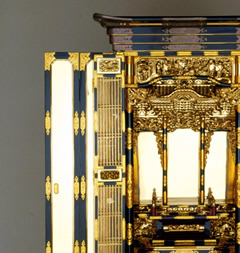NIIGATA SHIRONE Butsudan (Household Buddhist Altars)

A specialist in the construction of temples visited Niigata from Kyoto in the middle of the Edo era (1600-1868) and introduced various skills and techniques for making Kyoto-style household Buddhist altars. He also made a plain wooden altar, carving it in a simple manner by himself. This became the forerunner of Niigata Shirone household Buddhist altars.
In the latter part of the 18th century, skills and techniques unique to the area emerged and a production system was established, with each operation being performed by a skilled artisan.
Because household Buddhist altars are built to last, it is important that each piece has a sense of harmony and majestic dignity derived from the overall finish. This is accomplished by striking an appropriate balance between the inner and outer and sanctuaries (kuden and shumidan) as well as the quality and design of the carving and lacquer work decorations, the finish of the gilding, and the attachment of the fittings.
Feature
The essence of a household Buddhist altar comes from its durability and harmony. The balance among key pieces, including the shumidan base and the kuden palace, as well as the design of the engravings and maki-e gold lacquer paintings, the condition of the lacquering and gold leaf, and the quality of the gold finishings all play an important role in creating the majestic beauty that is fundamental to a household altar.
How to make
The base and the kuden palace are made using wood from Japanese cypress, white pine, and zelkova. The sculptured decorations of the altar and the gold finishings are also made according to the design. The finished base, the kuden and the wooden sculptures are then lacquered, the maki-e gold lacquer pictures are painted, the gold leafing is applied, and finally the gold finishings are set to complete the altar.

